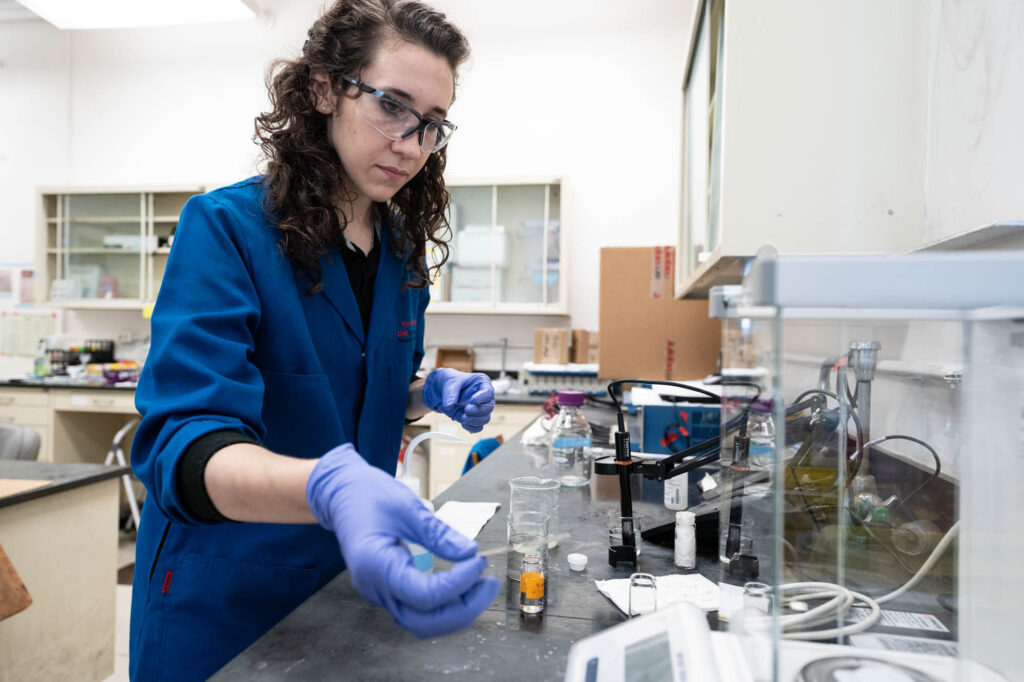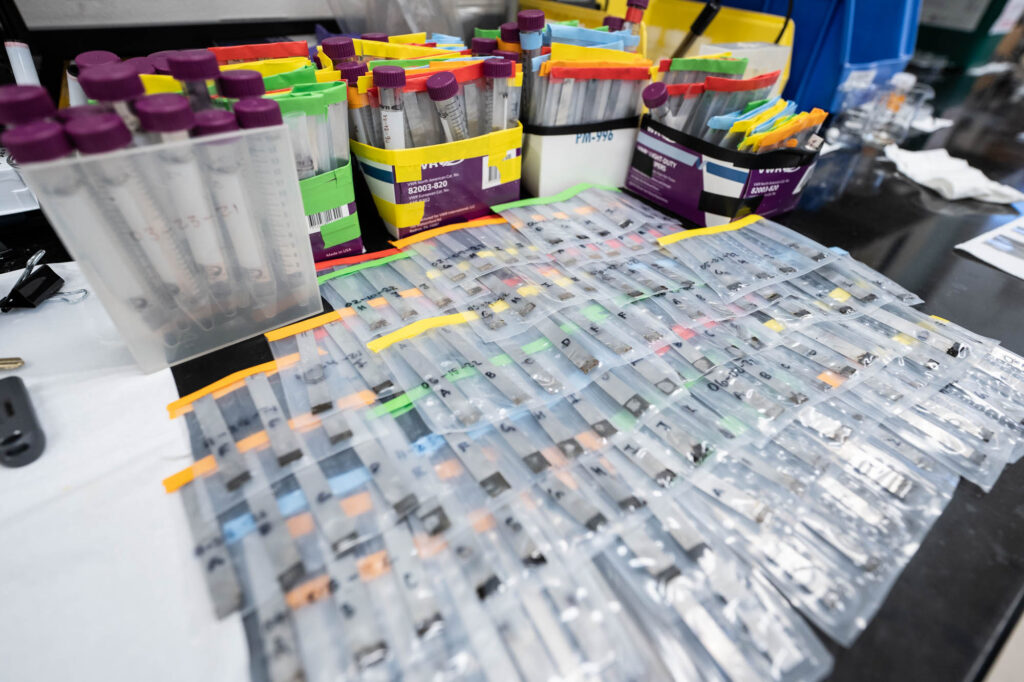Developing a zero-carbon method for processing iron ore
My name is Sara Spears and I am a third year PhD student at the University of Southern California. I work in the Chemistry Department, in Prof. Sri Narayan’s research group. I have spent the last three years studying electrodeposition of iron as a more environmentally sustainable alternative for iron ore processing. I currently have the honor of participating in the Wrigley Institute Summer Graduate Fellowship.

Most people have heard by now that most of the world’s active greenhouse gas emissions come from a handful of large industrial operations, rather than by individuals’ everyday activities. One of the largest contributors to this problem is the iron and steel industry. As of late 2021, according to a publication by Koutsoupa, et al. at the National Technical University of Athens, the iron and steel industry was responsible for 10% of global CO2 emissions. The portion of global emissions that the iron and steel industry is responsible for has been increasing steadily over the past several years. As energy smart appliances and electric vehicles are put into wide-scale use, their energy requirements (and associated emissions) decrease, making other emission sources more important to address. The contribution to emissions from the iron and steel also rises because of the increasing global demand for iron and steel products because of continued global development. As steel is a critical material for both new building efforts and recovery from disasters, a new method of producing iron and steel with zero-greenhouse gas emissions is needed.
Steel is made from iron, which comes from iron ore, which is a combination of iron oxides (FexOy) and various mineral components. The current method for processing iron ore is by melting it in a blast furnace, causing the iron oxide to separate from the other parts of the ore. Hot oxygen interacts with coal in the furnace to create carbon monoxide (CO), which then interacts with the iron oxides, taking up the oxygen to become carbon dioxide (CO2), and leaving plain iron behind. This results in cast iron (iron with a little bit of carbon in it, too brittle to be used in building applications), as well as staggering amounts of CO2. The cast iron then goes through further high temperature processing to become steel. Carbon dioxide is a greenhouse gas, which contributes to the warming of the planet and resulting climate change. For every ton of steel generated through the blast furnace process, 1.85 tons of CO2 are emitted. Combined with the global demand for steel being nearly 2 billion tons, and continuing to rise, the iron and steel industry is responsible for emitting a staggering amount of CO2 emissions, and this needs to be addressed promptly.

I study an alternative method for iron ore processing, which utilizes electrochemistry to convert iron ore to industrially relevant iron. The iron ore can be crushed and magnetically separated to collect only the iron-containing parts. The iron oxides can be dissolved into an acidic solution. The iron in the solution would exist as positively charged ions (cations). When current is passed through the solution, between two conductive plates called electrodes, electrons (negatively charged sub-atomic particles) will interact with the iron cations. The iron cations will then pick up the electrons, and become neutral iron, which will take away their ability to stay dissolved in the solution, and so the iron will then get deposited onto the electrode. This will continue until a significant amount of iron has been deposited onto the electrode. This process is called electrodeposition. This process will result in iron that is high purity and carbon free that can go through a single round of hot processing to become industrial grade steel. Besides the absence of carbon dioxide emissions, the main appeal for this process is the single step to isolate the iron, compared to the blast furnace that requires a first round of high temperatures to turn the ore into cast iron, and then another step to generate crude steel, followed by a third step that will add in the rest of the components to generate industrial grade steel or a specialty steel. The energy input required to maintain a solution that is about as hot as bath water is significantly lower (and cheaper!) than the requirement for several rounds of processing, at temperatures sufficient to melt iron ore.
I have studied several modifications of the electro-deposition approach, but my focus this summer for the Wrigley Institute Fellowship is to study the combined effect of selected modifications, specifically, the pH of the solution, the conductivity of the solution, and the temperature of the solution on the efficiency of the deposition, the compositional changes to the solution because of the deposition, and the resulting characteristics of the electro-deposited iron. My goal is to not just learn what the result of making these changes are, but to further my understanding of what underlying processes cause these changes and expressing these observations in a quantitative manner. The more we can fully understand the science behind the process while we are working in a laboratory scale, the better we will be able to anticipate the hurdles we will face as we embark on the scale-up of this process.

The electrodeposition process that I am studying is by no means the only alternative method of ore processing that is currently being explored worldwide. Other methods, such as using hydrogen from water electrolysis, have notable advantages. As long as some of these methods can be scaled up and implemented at an industrial scale, there will be a dramatic benefit for the environment. The iron and steel industry currently adds 3.7 billion tons of carbon dioxide to the atmosphere in just a year. Environmentally sustainable alternatives to iron ore processing, as long as they utilize renewable energy resources, are nearly, if not completely, carbon neutral. The application of these alternatives could go a long way to stopping the progression of global warming. I think it is also relevant to note that a lot of families and communities were hurt when the iron and steel industry left the United States because of its non-competitiveness. If these alternate processes were to be scaled up it could return the steel industry to the US and generate many American jobs in manufacturing. These sustainable iron ore processing alternatives are much more tolerable than the emission-heavy blast furnace facilities for a community to accept being built in their towns. The scaled up application of my research could then benefit the economy as well as help contribute to the modern trend of environmentally sustainable industrial development.

I would like to thank you very much for your time and attention today, as well as the Wrigley Institute for their support this summer and interest in my research.
